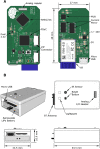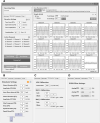Telemetry-controlled simultaneous stimulation-and-recording device (SRD) to study interhemispheric cortical circuits in rat primary somatosensory (SI) cortex
- PMID: 32903340
- PMCID: PMC7422589
- DOI: 10.1186/s42490-019-0019-7
Telemetry-controlled simultaneous stimulation-and-recording device (SRD) to study interhemispheric cortical circuits in rat primary somatosensory (SI) cortex
Abstract
Background: A growing need exists for neuroscience platforms that can perform simultaneous chronic recording and stimulation of neural tissue in animal models in a telemetry-controlled fashion with signal processing for analysis of the chronic recording data and external triggering capability. We describe the system design, testing, evaluation, and implementation of a wireless simultaneous stimulation-and-recording device (SRD) for modulating cortical circuits in physiologically identified sites in primary somatosensory (SI) cortex in awake-behaving and freely-moving rats. The SRD was developed using low-cost electronic components and open-source software. The function of the SRD was assessed by bench and in-vivo testing.
Results: The SRD recorded spontaneous spiking and bursting neuronal activity, evoked responses to programmed intracortical microstimulation (ICMS) delivered internally by the SRD, and evoked responses to external peripheral forelimb stimulation.
Conclusions: The SRD is capable of wireless stimulation and recording on a predetermined schedule or can be wirelessly synchronized with external input as would be required in behavioral testing prior to, during, and following ICMS.
Keywords: Brain-computer interface; Intracortical microstimulation; Primary somatosensory cortex.
© The Author(s) 2019.
Conflict of interest statement
Competing interestsThe authors declare that they have no competing interests.
Figures








Similar articles
-
Wireless simultaneous stimulation-and-recording device to train cortical circuits in somatosensory cortex.Annu Int Conf IEEE Eng Med Biol Soc. 2014;2014:426-9. doi: 10.1109/EMBC.2014.6943619. Annu Int Conf IEEE Eng Med Biol Soc. 2014. PMID: 25569987
-
A repetitive intracortical microstimulation pattern induces long-lasting synaptic depression in brain slices of the rat primary somatosensory cortex.Exp Brain Res. 2000 Dec;135(3):300-10. doi: 10.1007/s002210000530. Exp Brain Res. 2000. PMID: 11146808
-
Behavioral paradigm for the evaluation of stimulation-evoked somatosensory perception thresholds in rats.Front Neurosci. 2023 Jun 13;17:1202258. doi: 10.3389/fnins.2023.1202258. eCollection 2023. Front Neurosci. 2023. PMID: 37383105 Free PMC article.
-
Behavioral Paradigm for the Evaluation of Stimulation-Evoked Somatosensory Perception Thresholds in Rats.bioRxiv [Preprint]. 2023 May 5:2023.05.04.537848. doi: 10.1101/2023.05.04.537848. bioRxiv. 2023. Update in: Front Neurosci. 2023 Jun 13;17:1202258. doi: 10.3389/fnins.2023.1202258. PMID: 37205577 Free PMC article. Updated. Preprint.
-
Discriminability of Single and Multichannel Intracortical Microstimulation within Somatosensory Cortex.Front Bioeng Biotechnol. 2016 Dec 2;4:91. doi: 10.3389/fbioe.2016.00091. eCollection 2016. Front Bioeng Biotechnol. 2016. PMID: 27995126 Free PMC article.
Cited by
-
Progresses of animal robots: A historical review and perspectiveness.Heliyon. 2022 Nov 11;8(11):e11499. doi: 10.1016/j.heliyon.2022.e11499. eCollection 2022 Nov. Heliyon. 2022. PMID: 36411898 Free PMC article. Review.
-
Head-mounted optical imaging and optogenetic stimulation system for use in behaving primates.Cell Rep Methods. 2022 Nov 22;2(12):100351. doi: 10.1016/j.crmeth.2022.100351. eCollection 2022 Dec 19. Cell Rep Methods. 2022. PMID: 36590689 Free PMC article.
-
Repetitive microstimulation in rat primary somatosensory cortex (SI) strengthens the connection between homotopic sites in the opposite SI and leads to expression of previously ineffective input from the ipsilateral forelimb.Brain Res. 2020 Apr 1;1732:146694. doi: 10.1016/j.brainres.2020.146694. Epub 2020 Feb 1. Brain Res. 2020. PMID: 32017899 Free PMC article.
References
Grants and funding
LinkOut - more resources
Full Text Sources
